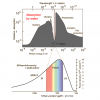Yeah, well explained, buddy! Your vulcan logic deserves to be mentioned...!
But do not forget we try to mimic the UVB strengths in 2000m height. The usually found intensities at sea level has not the same effect. Only near the equator or in heights above lets say 1000m minimum the UVB intensity is high enough to force the plant to produce more thc.
Mexico city is a good example or think on locations like nepal, the hindukush or the moroccan rif mountains..
All these areas have usually a higher UV index in summer(+10) and the intensity can reach up to 450μW/cm². The Kilimanjaro is near the equator "and" is pretty high and at 2000m you can measure +500μW/m² on a clear day and they still grow weed in this area(pretty good weed btw.).
Thing is even at 3000m height there is no light with 285nm, all below 295nm is still filtered out by the atmosphere.
With 285nm directly we would need probably much less intensity to make it work.
We need much more research in this area and specialized diodes that create a wider UVB/A spectrum but have a UVC filter to remove wavelengths below 285nm. 285nm + 365nm and a 1:3 - 1:5 ratio should work and maybe a glass cover that removes only the UVC part created by the 285nm diodes.
But the SPD should not have only two small spikes rather than two wider overlapping hills. Maybe a UVA/B light producing wideband phosphor using 285nm base diodes? I don't know if its possible to use the Solacure phosphor mix to create an LED phosphor with a wider UV range when combined with a 285nm UVB diode? I imagine something that work like a white diode. It's for sure not that easy but I could imagine something in this direction is possible somehow. 10-20% of the light created could still be 285nm but the rest gets converted into wideband UVA. Efficiency is not so important when you only need a few watts but to get the UVA/B light out of a single diode would make things so much easier.
Since more an more countries legalize MJ(not only in the US) there is a higher demand in UV lights and it is also interesting for the food industry and for medical needs.
I'm pretty sure it don't takes long until the industry presents the first AIO LED solutions.
Lol well I do love star trek references

A few things I wanted to hit on. Whether you're 3000m in elevation or 2m in elevation a 10 UV index will be pretty much the same regardless.

The UV index is a measuremt of UVB in 3 WV spots (295nm, 305nm & 325nm) with each WV given different weight on the final calculation than the other. This is due to the the absorption rate of UV light on most molecules.


The smaller the WV the more easily it is absorbed by water, DNA, ect, so the smaller the WV the greater the weight on calculated UV index. Australia is not very high elevation but has UV indexes of 14+! So UV index may correlate sometimes with elevation but it is actually only dependent on real life UVB radiation measurements regardless of elevation.
I'd have to ask for some data showing that 1000m elevation outdoors isn't enough UVB to notice a difference. They grow weed here in California pretty well and that's about sea level. Even vulcans will sunburn at the beach lol
μ (micro) = 1×10^(-6)
m (milli) = 1×10^(-3)
100μw/cm2 = 1w/m2
450μw/cm2 = 4.5w/m2 which is more than 8× more UVB radiation than a 10.6 UV index. I'm not sure what UV index that would correspond too.
500μw/m2 = 0.0005w/m2 and isn't very much UVB.
It'd be nice to have a PC UV chip, but 290ish nm chips are dismal effeciency and you'd have to use that as your pump because you can't upgrade photons. I think the best LED UV will be more than 2 WV. I'm trying to include as many as I can. So far I've found 305nm, 310nm, 320nm, 340nm, 365nm, 385nm, and 395nm.
I agree about 285nm. I want to try, but like you said I think there's benefit to a wider SPD. So if I'm going wide I'll have to include the other WVs anyways, so personally I'm going to try to reach into 290ish with my 305nm leg, but that's about as far as I'm going for targeting 285nm this time around. If I wasn't including other WVs then I think 1 or 2 chips of 285nm would achieve UVR8 activation like you enlightened me to in some of your earlier knowledge dumps
 https://en.m.wikipedia.org/wiki/Ultraviolet_index
https://en.m.wikipedia.org/wiki/Ultraviolet_index
EDIT:
They weight the area under the UV portion of the SPD towards 295 at 100% and 325nm at 0.3% I think they go all the way till 400nm at true 0% (exponential scale). Then this weighted quantity of UV radiation is divided by 25mw/m2 to determine UV index.
So
@Randomblame I believe my total radiation comparison in a 10.6 UV index day at 0.55w/m2 is off because I don't know the actual quantity (area under curve) from 290nm - 400nm, I only know 3 WV intensities. Looks like you'll have to downgrade my Vulcan status aha
I guess the take away for me is that UV index is a decent gauge imo when calculating a doseage range of UVB radiation, but that UV index says little about the quantity of UVA present.








